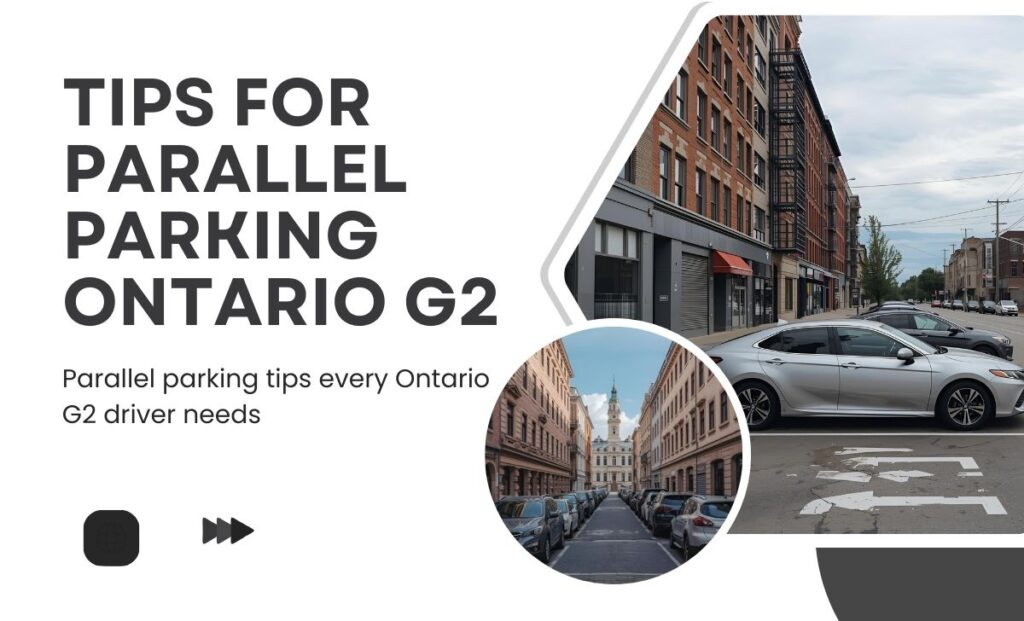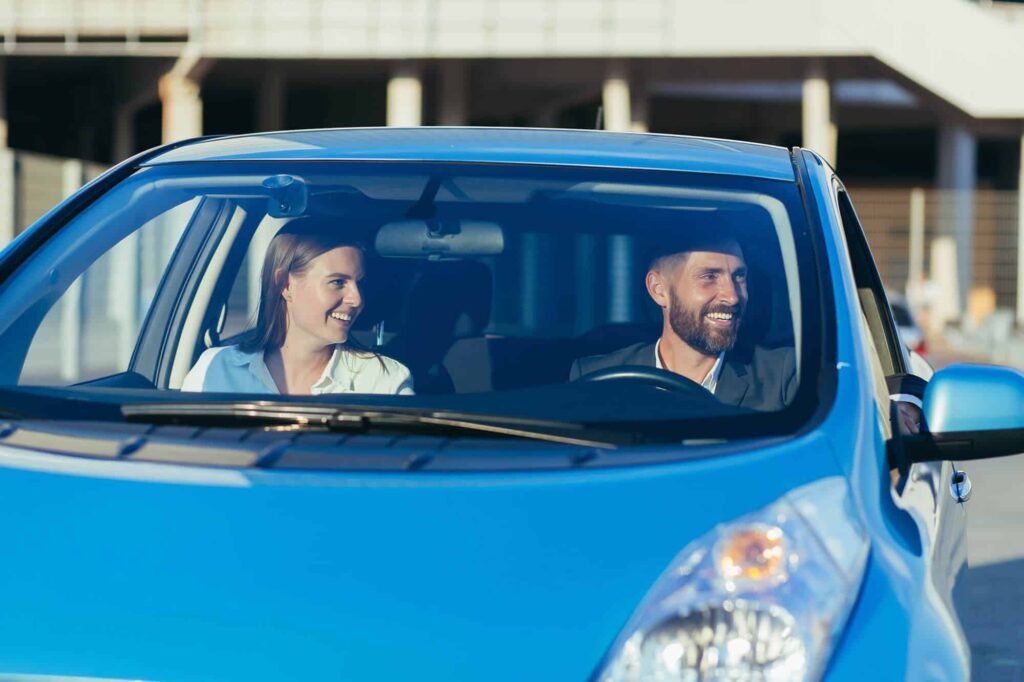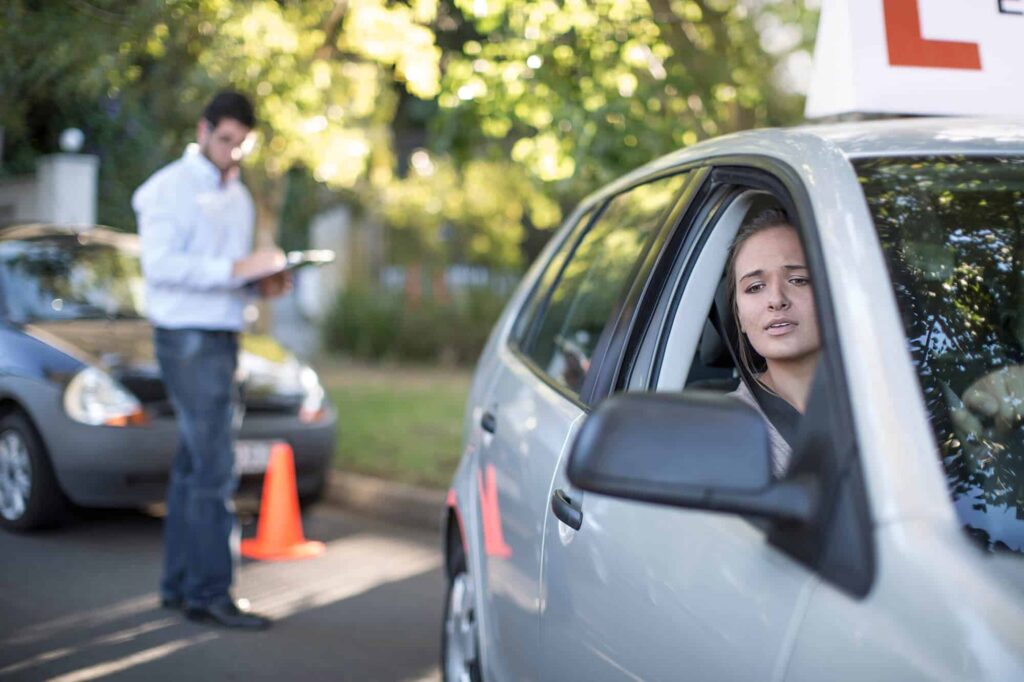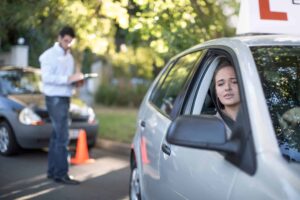If you ask ten G2 learners in Ontario what part of the driving test makes them the most nervous, at least eight will say parallel parking. Everything feels fine until that moment. You can handle stop signs, traffic lights, and even highway merges without breaking a sweat. Then the examiner points at a space and says, “Please parallel park here,” and suddenly your heart starts racing.
The truth is, you are not alone. Almost every new driver has felt the same way. Parallel parking has this reputation for being scary, but in reality it is just another skill. Once you know the steps and practice them often, it becomes as normal as making a right turn at a stop sign.
In the GTA, it is not just about passing your G2 test. Parallel parking is something you will need in real life. Think about squeezing into a spot downtown on Yonge Street, parking near Scarborough Town Centre on a busy weekend, or fitting into a tight curbside space in North York. These situations come up all the time. Learning it now will make your driving life much easier.
That is why this guide is here. I am going to break down the process step by step, share what examiners really look for, talk about common mistakes, and give you simple tips for parallel parking Ontario G2 learners can actually use. You will also read stories from real students who went from nervous to confident.
By the end, parallel parking will no longer feel like a test of nerves. It will feel like something you can handle calmly, safely, and with confidence both on test day and every day after.
Why Parallel Parking Matters in the G2 Test
Parallel parking is included in the G2 test for a reason. The Ministry of Transportation of Ontario does not put it there to make you nervous. It is a skill that shows you are ready to handle real traffic safely.
When you can parallel park well, it shows that you can:
- Control your car in tight spaces
- Use your mirrors, signals, and check blind spots correctly
- Make safe and deliberate moves without panicking
- Share the road safely with other cars, cyclists, and pedestrians
- Judge distance and space accurately
Think about downtown Toronto on a busy Saturday. Cars are lined up along the curb, cyclists weave between lanes, and pedestrians cross the street without warning. If you cannot parallel park, finding a spot becomes nearly impossible.
It is the same in Scarborough or Etobicoke, where residential streets often have cars parked on both sides. In East York, side streets near parks or schools can get crowded. Parallel parking is not just something you need for the test. It is a skill you will use almost every time you drive in the city.
Common Struggles Learners Face
Almost every learner has trouble with parallel parking at first. It is normal and nothing to be ashamed of. Here are the most common challenges:
- Not judging distance from the curb: Some drivers park too far from the curb, leaving their car sticking out. Others get too close and risk scraping the tires. Practice helps you find the right distance, usually 15 to 30 centimetres.
- Turning too early or too late: Timing matters. A turn that is even a little too soon or too late can make the maneuver harder.
- Forgetting mirror, signal, and blind spot checks: Always remember MSB. Missing them is a big mistake on the test.
- Feeling pressure from cars behind: Many learners panic when another car stops behind them. Rushing often leads to mistakes.
- Overthinking every move: Trying to remember every step can make you freeze. Parallel parking works best when it feels natural.
- Stress from road conditions: Hills, narrow streets, or sloped spots in the GTA can make parking feel harder.
- Fear of hitting another car: Worrying too much about bumping into a vehicle can make you overcorrect or stop too often.
- Different car sizes: Longer or wider cars behave differently. Take time to get used to the vehicle you are driving.
What the Examiner Wants to See
During your G2 test, the examiner is not expecting perfection. You do not need to park like a professional driver in a movie. What they care about is that you can park safely and stay in control.
Here is what examiners look for:
- Signal before starting: Let other drivers know what you are doing.
- Check mirrors and blind spots: Always look around before reversing.
- Smooth steering and braking: Avoid jerky movements.
- Stay close to the curb: Usually about 15 to 30 centimetres away.
- Do not hit cars or the curb hard: Minor bumps are bad, big ones are worse.
- Do not block traffic: Move carefully but don’t hold up other cars too long.
- Stay calm and confident: Panicking makes mistakes more likely.
Small mistakes, like being slightly too far from the curb, usually result in minor deductions. But forgetting blind spots or causing a safety issue can lead to failing the test. The key is showing control, awareness, and safe driving at every step.
Step by Step Tips for parallel parking Ontario G2
Now let’s break down the move. Imagine you are in Etobicoke on a two-lane street and the examiner asks you to parallel park.
Step 1: Choose a Spot
Look for a space that is big enough, at least one and a half times the length of your car. Don’t try to squeeze into a tiny spot, it will just make things harder.
Make sure it is a legal spot. No fire hydrants, driveways, bus stops, or areas with “No Parking” signs. If you can, pick a flat area and stay away from corners or places where other cars might get in your way.
If you are new to parking, pick a spot with plenty of space on both sides. This makes turning and backing up much easier. Take your time, line up your car carefully, and stay calm.
Step 2: Line Up
Start by signaling right so other drivers know you are going to park. Check your mirrors and look over your shoulder to make sure it is safe.
Pull up next to the car in front of the empty space. Leave about two to three feet between your car and theirs. This gives you enough room to turn without hitting the other car.
Line up your rear bumper with the rear bumper of the car next to you. This helps you back in straight and makes the whole process easier.
Take one more quick look around before you start backing in. Move slowly and stay in control. You can adjust as you go if you need to.
Step 3: Start Reversing
Put your car in reverse. Look in your mirrors and over your shoulder to make sure nothing is behind you.
Start moving slowly. Take your time. Going slow makes it easier to control the car and fix your angle if you need to.
Turn the steering wheel all the way to the right if you’re parking on the right side. Keep your foot ready on the brake so you can stop anytime.
Watch the car behind you and the curb. If it feels too close, stop, straighten a little, and adjust. Go step by step, and don’t worry if it takes a few tries.
Step 4: Create the Angle
Keep reversing slowly. Your goal is to get your car at about a 45-degree angle to the curb. Take it easy and don’t rush.
Here’s a helpful trick: look in your passenger-side mirror and watch for the inside headlight of the car behind you. Once you can see it, you are at the right angle to start straightening your car into space.
Stay calm and move slowly. This step is all about setting up the angle so you can finish parking smoothly.
Step 5: Straighten Out
Turn your steering wheel back to the center so your car starts lining up straight with the curb.
Keep backing up slowly. Move little by little and don’t rush. Going slowly makes it easier to stay in control and avoid scraping the curb or getting too close to the car behind you.
Look over your shoulder and watch the curb on the passenger side. Make small adjustments so your car is straight and nicely centered. Aim to be about 6 to 12 inches from the curb.
When your car is in the spot, put it in park and set the handbrake. Take a moment to relax and give yourself a pat on the back. You just parked successfully.
Step 6: Tuck In
Once your front bumper clears the car in front of you, turn your steering wheel all the way to the left.
Keep backing in slowly and gently. Let the car slide into the space while keeping an eye on the curb and the car behind you. Make small adjustments if needed to make sure you end up straight and centered.
Take it slow and stay calm. This step finishes getting your car neatly into the spot.
Step 7: Adjust and Finish
Straighten your wheels so your car is lined up nicely.
Move forward or backward a little if you need to center yourself in the space.
Check that you are about a foot away from the curb. This gives you enough space to open doors safely and keeps your car properly positioned.
And that’s it. You are parked! Take a moment to relax and feel good about it.
Practice Routines for Beginners
Parallel parking gets easier the more you do it. Here is a simple routine to help you practice step by step:
Start with cones
Go to an empty parking lot and use cones, buckets, or even backpacks to mark cars. This way, you can practice without worrying about hitting anything. Focus on turning, backing up, and getting the angle right.
Move to quiet streets
Once you feel comfortable, try quiet streets with little traffic. East York and Etobicoke have many calm residential streets where you can practice safely.
Add real cars
When you’re ready, practice between real parked cars. Take it slow and pay attention to spacing. This will help you get used to real-life situations.
Increase pressure
Try busier streets like in Scarborough or North York. Practice when a few cars are waiting behind you. This helps you stay calm under pressure.
Practice at different times
Try different times of day. Traffic and parked cars look different in the morning, afternoon, or evening. Practicing at different times prepares you for anything.
Short daily sessions
Even 10 minutes a day is enough. Short, regular practice works better than long, occasional sessions. Focus on getting a little better each time.
Watch and learn
If you can, watch someone experienced park. Notice how they line up, turn the wheel, and adjust. You can pick up simple tricks that really help.
Stay patient and relaxed
Don’t get frustrated if it doesn’t go perfectly. Everyone makes mistakes when learning. Take a deep breath, reset, and try again.
GTA Scenarios You Should Try
The GTA has lots of different streets where you can practice parallel parking. Each area helps you learn something new:
- Downtown Toronto: Spaces are smaller and traffic is heavier. This is a good place to practice staying calm and focused while parking.
- Scarborough: Streets are wider but there are more cars. Practice patience and taking your time to line up correctly.
- North York: Many streets are narrow with cars parked on both sides. This helps you work on precision and careful steering.
- Etobicoke: Some streets are sloped, which can make your car roll slightly. Practice using your brakes well and controlling your speed.
Pro Tips That Really Help
Smart advice from the pros to help you pass and drive safely
- Adjust your side mirror slightly downward so you can see the curb. This helps you judge the distance and avoid scraping your tires.
- Move slowly. Back up almost at walking speed. Slower movement gives you more control and time to correct mistakes.
- Use small steering adjustments instead of big ones. Tiny turns make it easier to line up straight and stay in the space.
- Take a deep breath if you feel nervous. Calm yourself before starting. Feeling relaxed makes parking easier.
- Don’t be afraid to start over. If something goes wrong, pull out and try again. Each attempt is practice.
- Check your mirrors often. Look at the curb and the car behind you from different angles. It gives you better awareness of your surroundings.
- Practice both sides. Try parking on the left and right sides of the street so you are comfortable in any situation.
- Keep your hands on the wheel in the proper position. It helps with smoother, more controlled turns.
- Use reference points. For example, lining up your bumper with the car in front, or watching for the curb in your side mirror. Small tricks like this make parking easier.
- Stay patient. Parallel parking takes time to master. Don’t rush, and celebrate small improvements along the way.
Common Mistakes and How to Fix Them
Parallel parking can be tricky, but most mistakes are easy to fix. Knowing what to watch for will make parking less stressful.
- Too far from the curb: Restart and make a sharper turn on your second move
- Hitting the curb: Pull forward, straighten, and try again
- Forgetting blind spots: Say “mirror, signal, blind spot” out loud each time until it becomes habit
- Rushing because of other cars: Remember, your test matters more than a stranger’s impatience
How Driving Schools Make It Easier?
Get confident behind the wheel with tips from professional instructors.
- Build Confidence: With practice and guidance, parallel parking becomes less stressful and more manageable.
- Helpful Tricks: Instructors show easy ways to line up using your mirrors, rear window, or the curb.
- Practice Like the Test: Simulate real G2 test conditions so you’re more confident on the big day.
- Know the Test Spots: Learn the streets and areas examiners usually use in the GTA.
- Step-by-Step Guidance: Break the maneuver into simple steps that are easy to follow.
- Quick Feedback: Get tips right away to fix mistakes and improve faster.
Final Thoughts: Confidence Comes With Practice
Parallel parking is not a mystery, and it is not impossible. It is a simple skill that feels scary until you do it enough times.
Remember these key points:
- Signal, mirror, and blind spot checks are the most important parts
- Take it slow, do not rush
- Start with easy practice, then move to harder spots
- Do not worry about cars waiting behind you
- The examiner wants to see safety, not perfection
Every confident driver in Toronto, Scarborough, Etobicoke, and North York once felt nervous about parallel parking. You will get there too. Practice a little every day, stay calm, and trust the process.
So when your examiner says, “please parallel park here,” you’ll smile, take a deep breath, and show them you know exactly what to do.
Ready to get there faster? Book a lesson with our MTO Approved Driving School in Toronto and practice with expert instructors who make parallel parking simple and stress-free.






